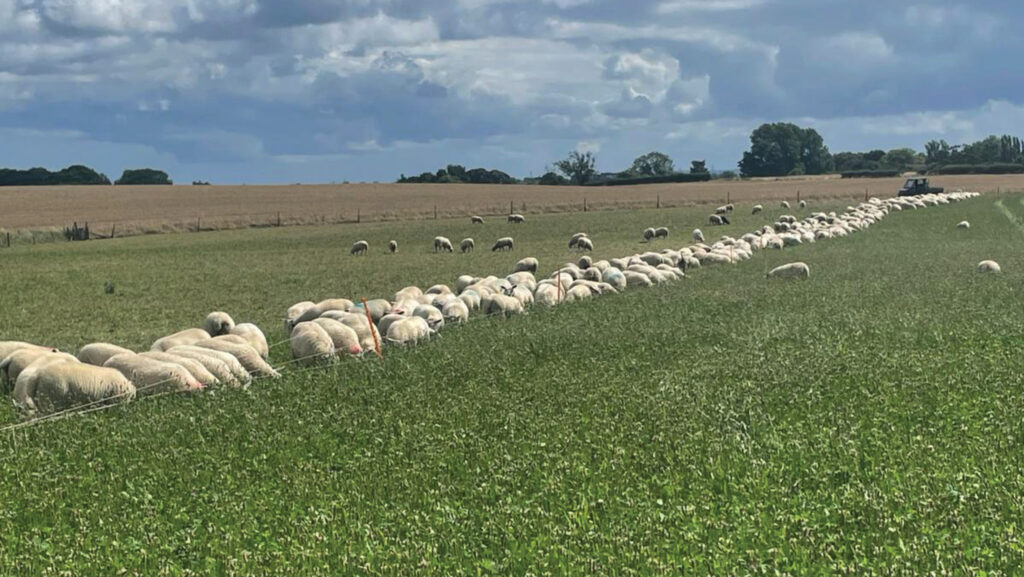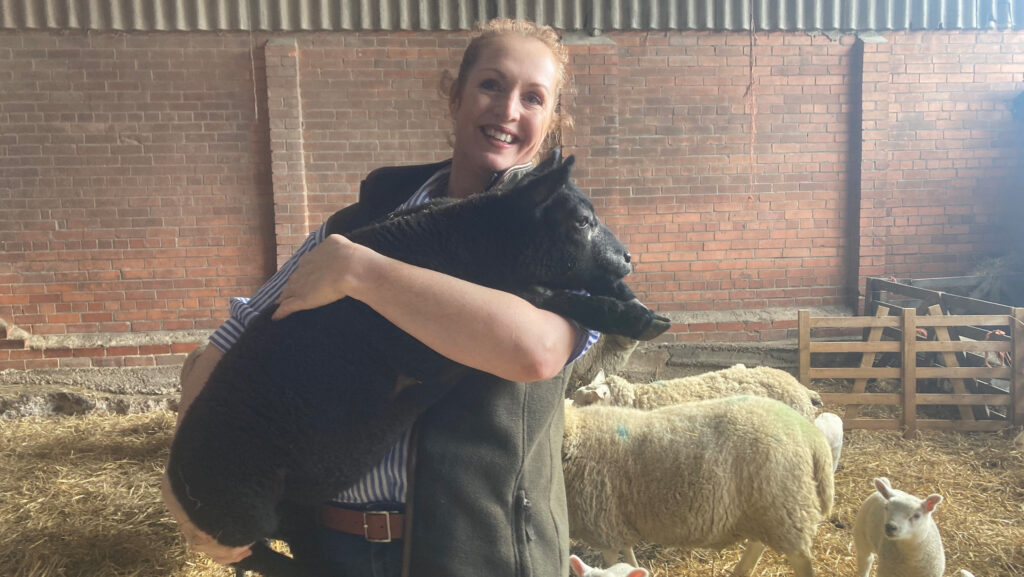Why simple herbal ley mix benefits Durham mixed farm
 © Clare Wise
© Clare Wise Government clarification that growing one herb, one legume, and one grass together qualifies as a herbal ley under the Sustainable Farming Incentive is grist to the mill of a County Durham farm.
Husband and wife partnership Clare Wise and Stewart Chapman of Manor Farm, near Darlington, were quick to sign up for the Sustainable Farming Incentive (SFI) scheme and capitalised on the simple definition of a herbal ley.
See also: 8 expert tips for efficiently grazing herbal leys
They see it as a great way to build resilience in their system in the challenging Tees Valley microclimate.
“Our land is very heavy, and rain often misses us in summer, so we can be very wet in winter and quickly become droughty in summer,” says Clare.
She thinks increasing pasture diversity and rooting depths makes good sense agriculturally and says she would grow herbal leys even without the SFI.
SFI eligibility
Under SFI rules, the simple mixes they have grown are eligible for payment under the SAM3 option and can be cut and grazed as they see fit (see “SAM3 herbal leys: Aims of the scheme”).
Clare explains that the farm did not enter the GS4 option in the Countryside Stewardship scheme as it was too complicated and required leys to be given a five-week rest between 1 May and 31 July.
She says her NFU contacts lobbied for clarification as to what the scheme demanded, which confirmed that a simple mix of one herb, one legume and one grass qualifies.
“We have got into SAM3 early and it’s allowing us to drill simple mixes to cut out fertiliser use, build soil health with more varied root structures, and get lambs away without creep. The GS4 option just didn’t work for us.”
Farm facts
Manor Farm, Darlington

Clare Wise © Michael Priestley
- 222ha mixed livestock and arable
- 80ha in grass, of which 5ha is permanent pasture
- Four-to-five-year grass ley breaks in arable rotation
- Heavy clay loam and clay soils
- 460 continental-cross ewes
- Using mostly New Zealand Suffolk and Sufftex rams
- 60 Limousin and Belgian Blue-cross suckler cows
- Cattle sold liveweight at Northallerton auction
- Prime lambs sold liveweight at Darlington
- Sold 168% lambs last year
Benefits
Herbal leys have replaced ryegrass and white clover leys. The key benefits to Clare and Stewart’s farm business, besides the SFI payment, are:
- Performance Up to 90% of the lambs are finished without any hard feed two to three weeks earlier on the herbal leys. From weaning to slaughter, lamb daily liveweight gain was 280-290g/day.
- Durability Deeper rooting plants and drought-tolerant plantain mean pasture keeps on growing for longer during dry spells, tolerates wet periods and recovers after light poaching.
- Versatility The leys have produced good-quality silage for growing cattle and late-gestation sheep, and provide valuable grazing for lactating ewes and weaned lambs.
- Cost control Grassland fertiliser applications have reduced 60-70% and in some cases no fertiliser is applied.
- Productivity Because lambs are reaching slaughter weight earlier and rotational grazing produces more grass, there are more grazing options later in the summer to build condition on thinner ewes to support scanning percentages.
How it works
Clare and Stewart aim to eventually establish 70ha (173 acres) of herbal leys, covering all improved grassland and grass leys in the arable rotation. So far, they have drilled the following:
- Field one 12ha (30 acres) with equal parts perennial ryegrass, white clover, red clover and plantain, with a small amount of chicory. Sown later than planned in the wet August of 2023.
- Field two 8.5ha (21 acres) of 30% plantain, 20% red clover, 20% white clover and 30% ryegrass. This was drilled in early August 2022.
- Field three 5ha (16 acres). A standard ryegrass and clover mix, sown three years ago, was overseeded last year with chicory and plantain to qualify for SAM3. More seed will be added this year to qualify for the payment as the original seed did not take because of waterlogging.
Establishment and grazing strategy
The current system comprises one pass with a 4m primary cultivator in cereal stubble, a roll, and then a pass with a 6m sabre tine drill.
Ewes and lambs head out from the lambing shed to graze in March, having been fed a grass silage-based total mixed ration. They are lightly stocked on herbal leys.
Ewes with twins are targeted at this pasture as it provides a high-quality feed.
When pasture growth accelerates in late April/May, the fields are subdivided into 2ha (5-acre) blocks and sheep are moved every five days.
Last year’s strong summer growth led Clare to strip-graze 800 lambs on 0.4ha daily moves. No fertiliser was used and lambs were finished without creep or fertiliser.
Clare hopes rotational grazing will help sustain the herbs for the three years required for the SAM3 payment. She may let the sward go to seed to replenish the species and save on redrilling.
Milk thistles have sprung up, particularly in field two, despite them not being a problem previously. The plan is to deal with these by roguing.
SAM3 herbal leys: aims of the scheme
The Rural Payments Agency has told Farmers Weekly that actions taken to increase pasture diversity to qualify for SAM3 must meet the aims of the scheme, which are to:
- Provide varied root structures
- Help improve and maintain soil structure, carbon, biology and fertility.
Claire Robinson, NFU senior countryside adviser, said it was great for farmers to have clarity from the government about the SAM3 option under the Sustainable Farming Incentive (SFI).
However, she stressed that SFI will continue to adapt, and the definition of a SAM3 herbal ley may change going into the summer.
She said: “I think farmers appreciate the level of flexibility in SFI. If people are used to the prescriptive approach of Countryside Stewardship, then SFI is definitely more flexible.
“Talk to other farmers who have experience of growing herbal leys and the benefits it brings. Don’t do it half-heartedly, research them and get the most out of them.”
Strength in pasture diversity
Farmers looking at the herbal ley option under the Sustainable Farming Incentive should ensure they achieve pasture diversity and meet the aims of the scheme, advises an independent seed and forage specialist.
Francis Dunne of FD Seeds warns farmers interested in the SAM3 option that Defra could produce more prescriptive requirements in future.
However, he says a mix of one grass, one legume and one herb could be useful, as evidenced by the mix of perennial ryegrass, clover and plantain that is popular in New Zealand.
He says some huge drilling campaigns have started, with blocks of up to 200ha (494 acres) of arable ground being drilled at a time to qualify for SAM3.
Once established, he recommends limiting or avoiding fertiliser use to avoid ryegrasses dominating, and to rotationally graze on rounds of at least 30 days to give herbs a chance to recover.
He also advises that timothy and cocksfoot are worthwhile additions to many mixes for their drought tolerance and early growth patterns.
